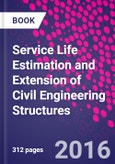Service life estimation is an area of growing importance in civil engineering both for determining the remaining service life of civil engineering structures and for designing new structural systems with well-defined periods of functionality. Service life estimation and extension of civil engineering structures provides valuable information on the development and use of newer and more durable materials and methods of construction, as well as the development and use of new techniques of estimating service life.
Part one discusses using fibre reinforced polymer (FRP) composites to extend the service-life of civil engineering structures. It considers the key issues in the use of FRP composites, examines the possibility of extending the service life of structurally deficient and deteriorating concrete structures and investigates the uncertainties of using FRP composites in the rehabilitation of civil engineering structures. Part two discusses estimating the service life of civil engineering structures including modelling service life and maintenance strategies and probabilistic methods for service life estimation. It goes on to investigate non-destructive evaluation and testing (NDE/NDT) as well as databases and knowledge-based systems for service life estimation of rehabilitated civil structures and pipelines.
With its distinguished editors and international team of contributors Service life estimation and extension of civil engineering structures is an invaluable resource to academics, civil engineers, construction companies, infrastructure providers and all those with an interest in improving the service life, safety and reliability of civil engineering structures.
- A single source of information on the service life of reinforced concrete and fibre-reinforced polymer (FRP) rehabilitated structures
- Examines degradation mechanisms in composites for rehabilitation considering uncertainties in FRP reliability
- Provides an overview of probabilistic methods for rehabilitation and service life estimation of corroded structures
Part one discusses using fibre reinforced polymer (FRP) composites to extend the service-life of civil engineering structures. It considers the key issues in the use of FRP composites, examines the possibility of extending the service life of structurally deficient and deteriorating concrete structures and investigates the uncertainties of using FRP composites in the rehabilitation of civil engineering structures. Part two discusses estimating the service life of civil engineering structures including modelling service life and maintenance strategies and probabilistic methods for service life estimation. It goes on to investigate non-destructive evaluation and testing (NDE/NDT) as well as databases and knowledge-based systems for service life estimation of rehabilitated civil structures and pipelines.
With its distinguished editors and international team of contributors Service life estimation and extension of civil engineering structures is an invaluable resource to academics, civil engineers, construction companies, infrastructure providers and all those with an interest in improving the service life, safety and reliability of civil engineering structures.
- A single source of information on the service life of reinforced concrete and fibre-reinforced polymer (FRP) rehabilitated structures
- Examines degradation mechanisms in composites for rehabilitation considering uncertainties in FRP reliability
- Provides an overview of probabilistic methods for rehabilitation and service life estimation of corroded structures
Table of Contents
Part 1 Using fibre reinforced polymer (FRP) composites to extend the service-life of civil engineering structures:- Key issues in the use of FRP composites in the rehabilitation and retrofitting of concrete structures
- Using FRP composites to extend the service life of corroded concrete structures
- Areas of uncertainty in the use of fibre-reinforced polymer (FRP) composites in the rehabilitation of civil engineering structures
- Rehabilitation and service life estimation of bridge superstructures.
Part 2 Estimating the service life of civil engineering structures:
- Service life, reliability and maintenance of civil structures
- Probabilistic methods for service life estimation of civil engineering structures
- Non-destructive evaluation and testing (NDE/NDT) of civil structures rehabilitated using FRP composites
- Structural health monitoring and field validation of civil engineering structures
- Databases and knowledge-based systems for service-life estimation of FRP rehabilitated civil engineering structures
- Pipeline rehabilitation systems for service-life extension.bilitation systems for service-life extension.
Author
Karbhari, Vistasp M. Vistasp M. Karbhari is President of the University of Texas at Arlington, USA. Professor Karbhari has an international reputation for his research on the use of composites in civil engineering.Lee, L S Professor Luke S. Lee is an Assistant Professor of Civil Engineering in the School of Engineering and Computer Science at the University of the Pacific, USA. He is well-known for his research on the rehabilitation of civil infrastructure using composite materials, structural health monitoring and service life estimation.








